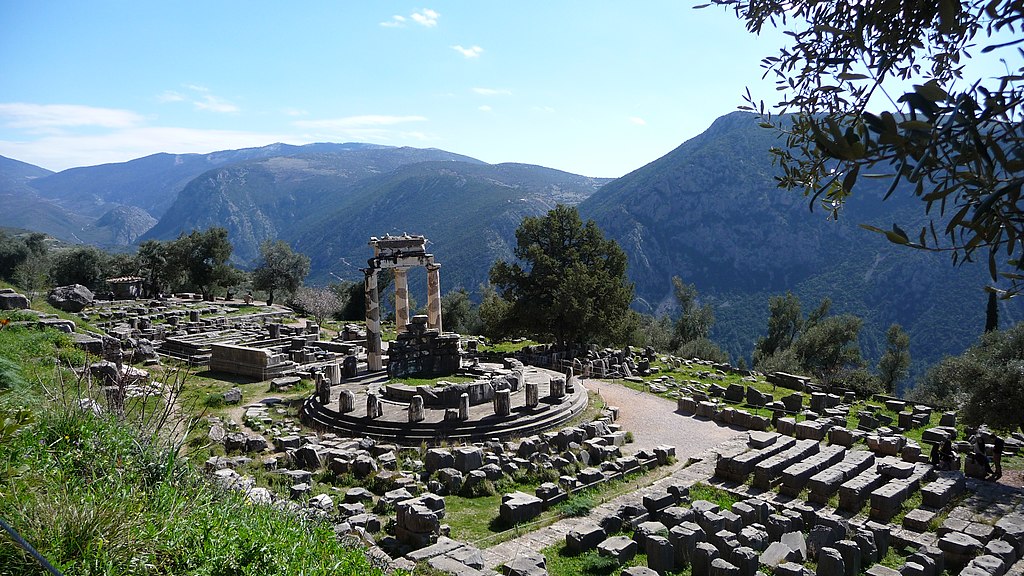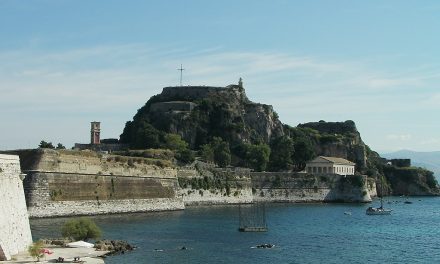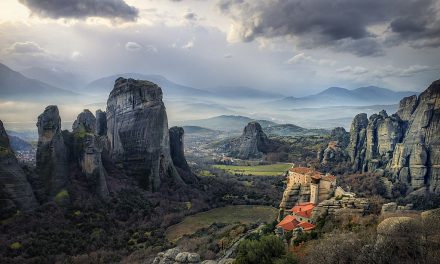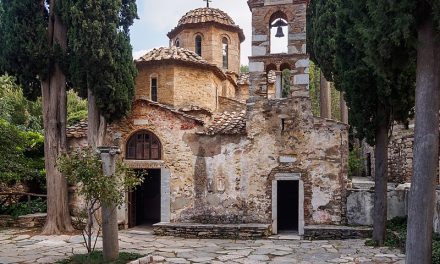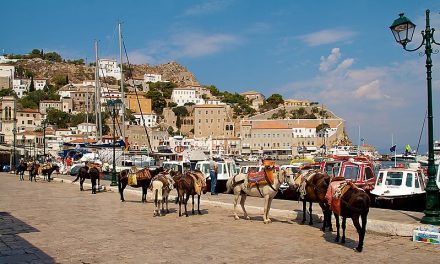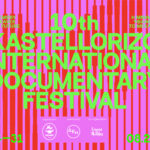One of the most important archaeological sites in Greece, home to the most famous oracle of the ancient world and revered as the centre of the world, lies at the foot of Mount Parnassus in central Greece; Delphi has been part of the UNESCO World Heritage List since 1987.
Delphi in myth
Both the site’s history and the myths and legends around it have almost invariably been associated with the art of divination. According to various myths, it was originally the centre of the cult of the primordial goddess Gaia (the personification of the Earth), and was guarded by a beast born by Gaia herself: a serpent-like dragon named Python (hence the eponymous genus of constricting snakes, named many centuries later), which also possessed the gift of prophecy. The monstrous snake wreaked havoc on the surrounding area, terrorising and often killing people and animals.
According one popular version of the myth, when the goddess Leto became pregnant with Zeus’s twins, Apollo and Artemis, a jealous Hera set Python upon her; Leto fled the dragon but was unable to find refuge, until eventually she found herself on the sacred island of Delos, supposedly the only place not attached to land, where she gave birth. Apollo (who, according to one myth, grew supernaturally fast after being fed with nectar and ambrosia) soon set up to slay Python, not only to avenge his mother, but also to take hold of the site (named Pytho, after the dragon) and establish his own sanctuary there. He thereupon took the epithet Pythios and his oracle was called Pythia. In his interpretation of the myth, Robert Graves would argue that it symbolises the capture of a pre-Hellenic shrine by a Hellenic tribe.
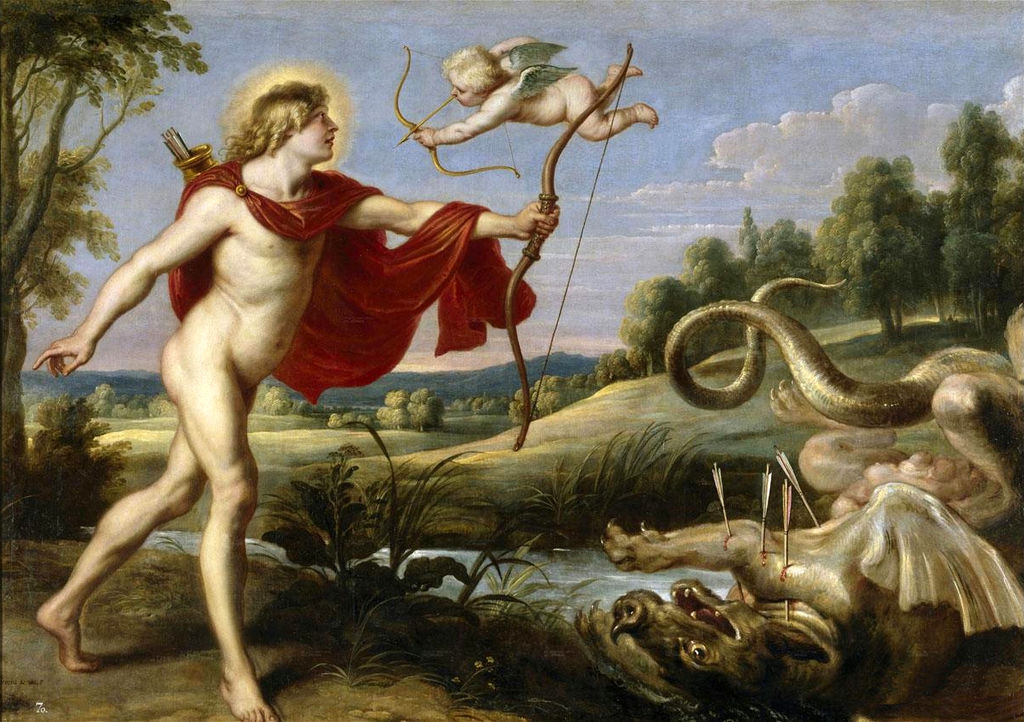 Apollo and the Python, 1636–1638, Peter Paul Rubens and Cornelis de Vos
Apollo and the Python, 1636–1638, Peter Paul Rubens and Cornelis de Vos
According to the Homeric Hymn to Apollo (which was, however, not written in the Homeric times), the monster (here, a she-dragon) is left nameless, and the place is named after the verb pytho (to decay, to smell of rot – a cognate of the word “pus” in Latin and in English) due to the beasts body which was left there to decompose under the sun. Apollo is then said to have taken the form of a dolphin to guide some Cretan sailors to the land of Pytho, to serve as his priests; he would then give himself the epithet Delphinios, hence the name of the sanctuary.
However, the name is generally believed to have originated from the word delphus meaning “womb”, which is in congruence both with its status as the original place of worship of Gaia, a primeval mother goddess, especially considering it was hailed as the centre of the Earth – Gaia’s navel. Dolphin imagery was nevertheless often used in Apollo’s worship, due his epithet Delphinios. The word dolphin itself (delphis) is derived form delphus, probably to indicate that it is a mammal, despite it fish-like characteristics.
Another famous legend regarding Delphi features Zeus, the ruler of gods, who tries to determine the centre of the Earth. He releases to eagles who fly from opposite directions, coming from the two edges of the universe, and meet in Delphi.
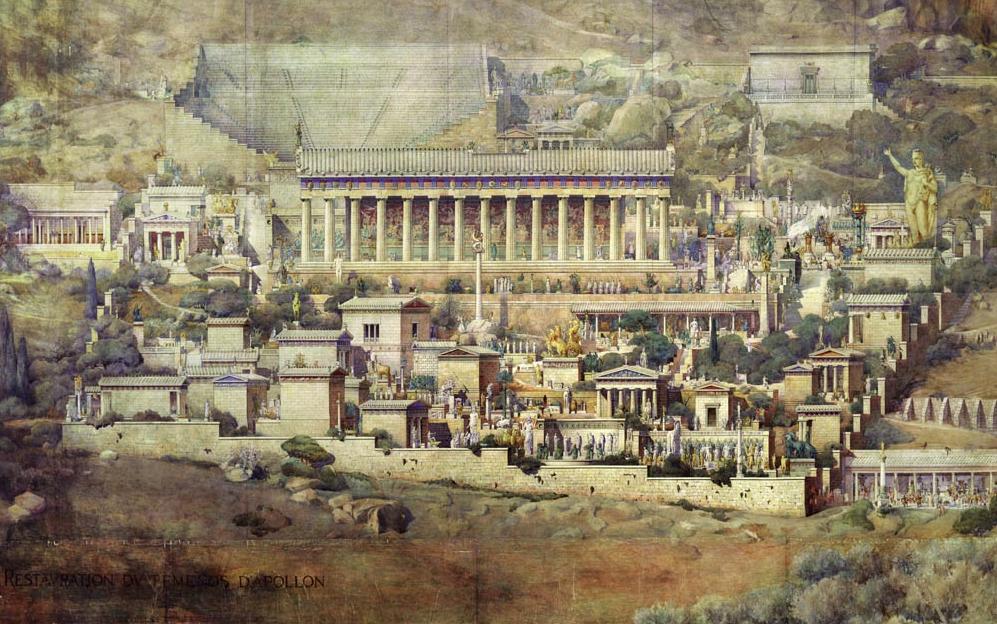 Illustration by Albert Tournaire, depicting a speculative reconstruction of Apollo’s Temple (1894, École Nationale Supérieure des Beaux-Arts, Paris)
Illustration by Albert Tournaire, depicting a speculative reconstruction of Apollo’s Temple (1894, École Nationale Supérieure des Beaux-Arts, Paris)
Delphi in history
The first signs of human presence in the area date back to the Neolithic period (4th millennium BC), while the ruins of a settlement and a cemetery that were discovered within the site date back to the Mycenaean period (1500-1100 BC). These first traces are, however, very rare and fragmentary at least until the 8th century, a period when the sanctuary of Apollo is believed to have been established, as attested by the numerous votive objects discovered on the site.
From that point on, Delphi would gradually grow in prestige within the Greek world, leading to the construction of the first stone temples towards the end of the 7th century: one dedicated to Apollo and the other to Athena. In the period spanning from the 6th to the 4th century, Delphi reached the peak of its glory; its fame and religious authority spread throughout the Mediterranean region, sometimes even going beyond the borders of the Greek world. Pilgrims from all parts of the then known world flocked to the oracle, often bringing with them lavish offerings.
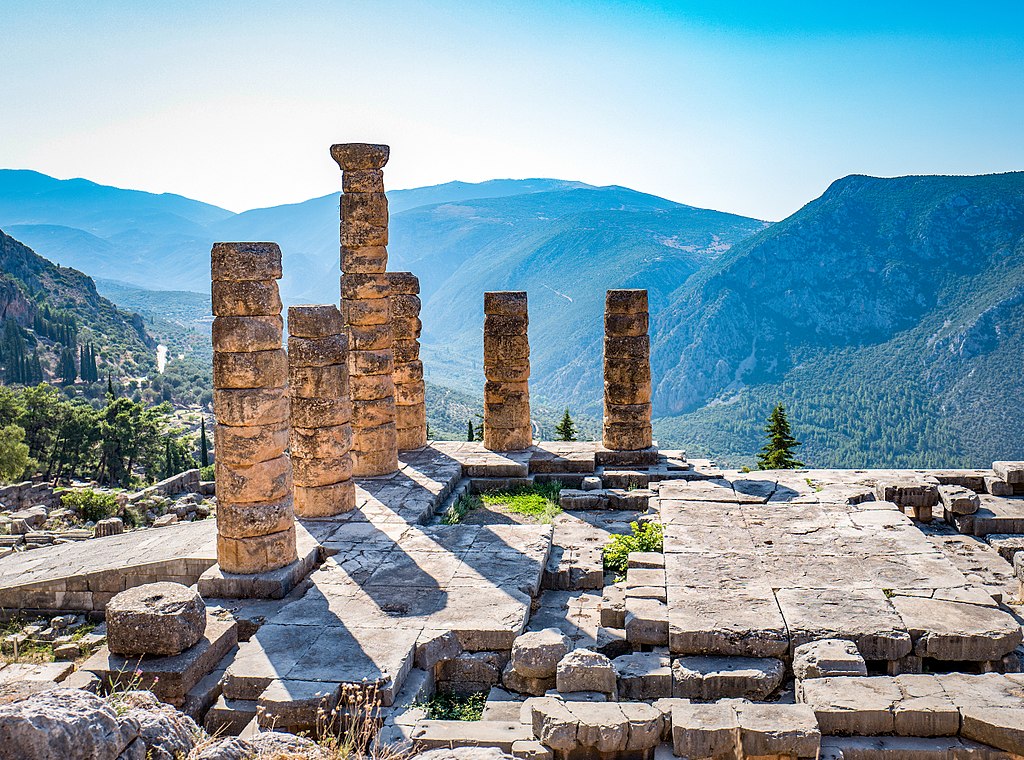 View of the remains of Apollo’s temple (by Skyring via Wikimedia Commons)
View of the remains of Apollo’s temple (by Skyring via Wikimedia Commons)
The founding of the Delphic Amphictyony, also known as the Great Amphictyonic League, at some point in the 6th century, further established the status of Delphi in the Greek world. Amphictyonies were associations of tribes that started out as religious alliances, but their political and military importance would progressively grow; one of the most ancient ones had been centred on Apollo’s older sanctuary on the island of Delos. An amphictyonic league of neighbouring tribes from Central Greece and Thessaly already existed in earlier times for the protection of Demeter’s temple in Anthela, close to Thermopylae; after Delphi joined the league, the Pythians exerted increasing influence on it until its centre shifted from Demeter’s sanctuary to that of Apollo, although the league continued to manage both temples.
The Delphic Amphictyony, consisting of twelve tribes, had as its original purpose the management and protection of the sanctuaries; however, its political and military importance grew progressively. It was administered by a council (the Synedrion) comprising of two delegates from each tribe, meeting twice a year, in Delphi at springtime and in Anthela in autumn. Apart from the superintendence of the temples, one of the main functions of the league was the regulation of wartime conduct between the members: although they were not prevented from fighting each other, it was forbidden to completely obliterate a member city or to cut off its water supplies.
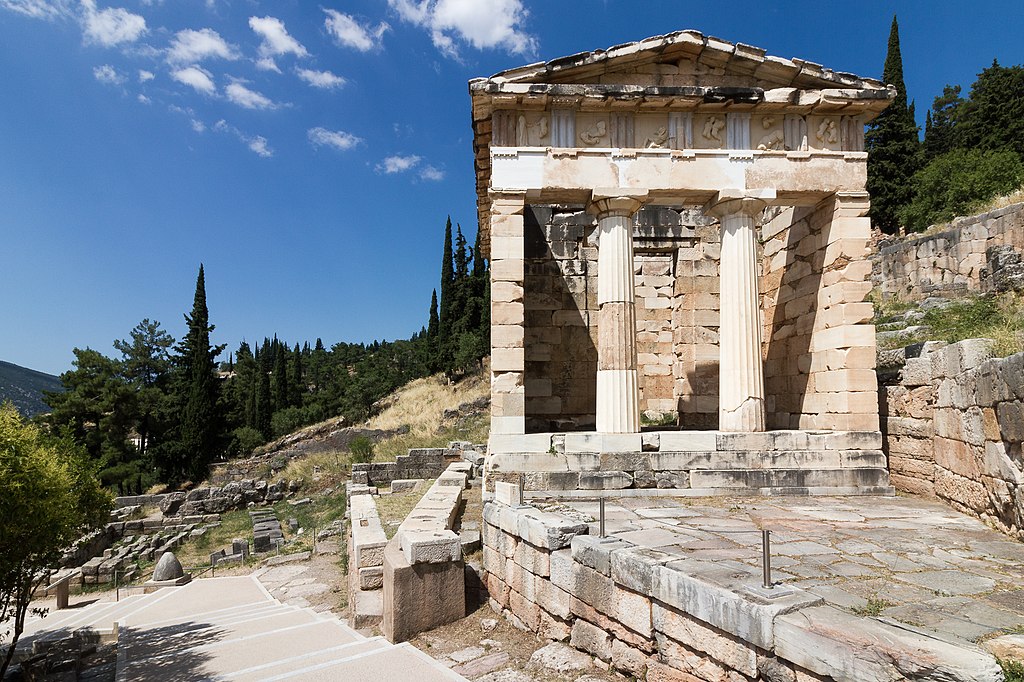 The Treasury of the Athenians (by Szymon Kobalczyk via Wikimedia Commons)
The Treasury of the Athenians (by Szymon Kobalczyk via Wikimedia Commons)
The amphictyony’s influence in matters of relations between the various Greek cities would continually increase, as it comprised members from the most important city-states (such as Athens, Sparta and Thebes) but also from others, less powerful. Rivalries between city-states and the power struggles for control over the sacred site would lead to the four “Sacred Wars” which took place from the early 6th until the late 4th century.
Another important role of the Delphic Amphictyony was the organisation of the Pythian Games, one of the four Panhellenic Games of Ancient Greece, second in importance only to the Olympic Games. The origin of the games is very old, and the myths link them with the slaying of the dragon Python by Apollo. From 582 BC onwards, their administration was entrusted to the league, and they began to take place every four years, in August, one year before each of the Olympics. They featured music, poetry and prose contests as well as athletic ones, and brought together representatives from rivaling cities in a spirit of unity and sportsmanship. Victors were crowned with laurel wreaths, as bay laurel was Apollo’s sacred plant. They continued to be held until the 4th century AD, with theatrical competitions introduced in Roman times.
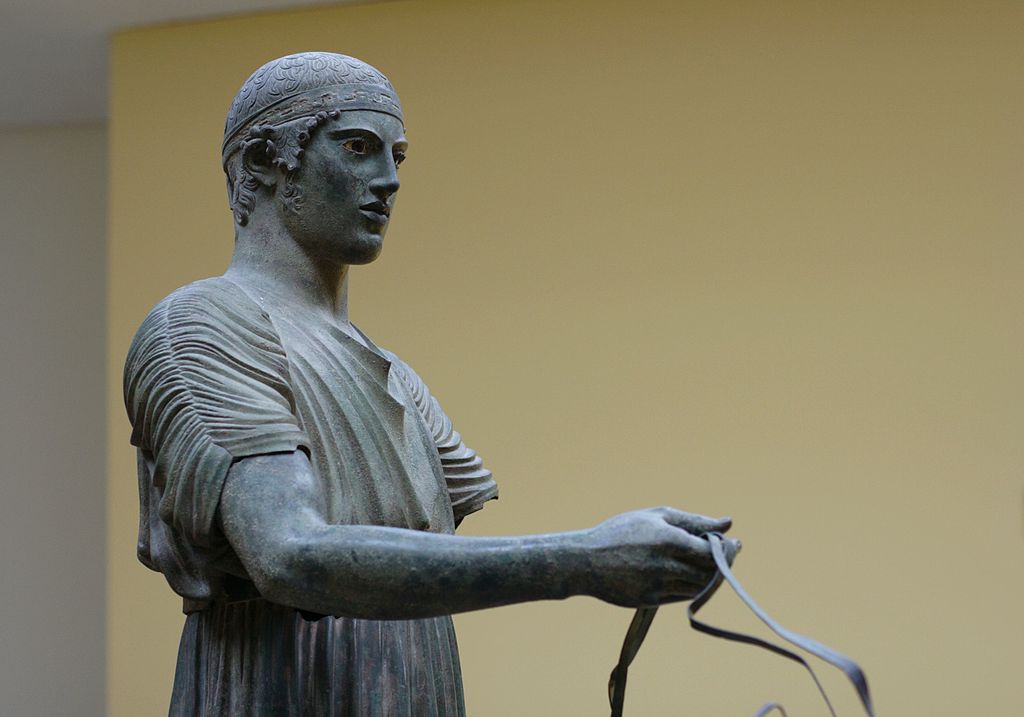 The Pythian Games included chariot races, as attested by the bronze statue of the Charioteer, one of the most famous ancient Greek sculptures (Delphi Archaeological Museum, by Zde via Wikimedia Commons)
The Pythian Games included chariot races, as attested by the bronze statue of the Charioteer, one of the most famous ancient Greek sculptures (Delphi Archaeological Museum, by Zde via Wikimedia Commons)
The oracle
Apart from Delphi’s status as a place of influence and a sacred competitions, Apollo’s sanctuary remained above all a place where kings and common folk alike would go to seek answers to their most pressing problems, hoping that the oracle would predict their future and help them make the correct decisions. The faithful believed that it was the God Apollo himself who spoke through the lips of the high priestess, known as Pythia, as Apollo was the most important god associated with the power of divination.
Before giving a prophecy, the Pythia cleansed herself in the sacred waters of the Castalian Spring, chewed laurel leaves and got into the adyton (the restricted area within the temple) where she would sit on a tripod above the smoke coming up from burning herbs with hallucinogenic powers, in order to enter a state of trance during which Apollo supposedly possessed her. Then she would utter words and cries that were often unintelligible or nonsensical, and which would then be interpreted into an oracle (a prophetic response known in Greek as hrismos) by a group of priests who were present. The transcriptions of the prophecy were often in verse, especially in earlier times.
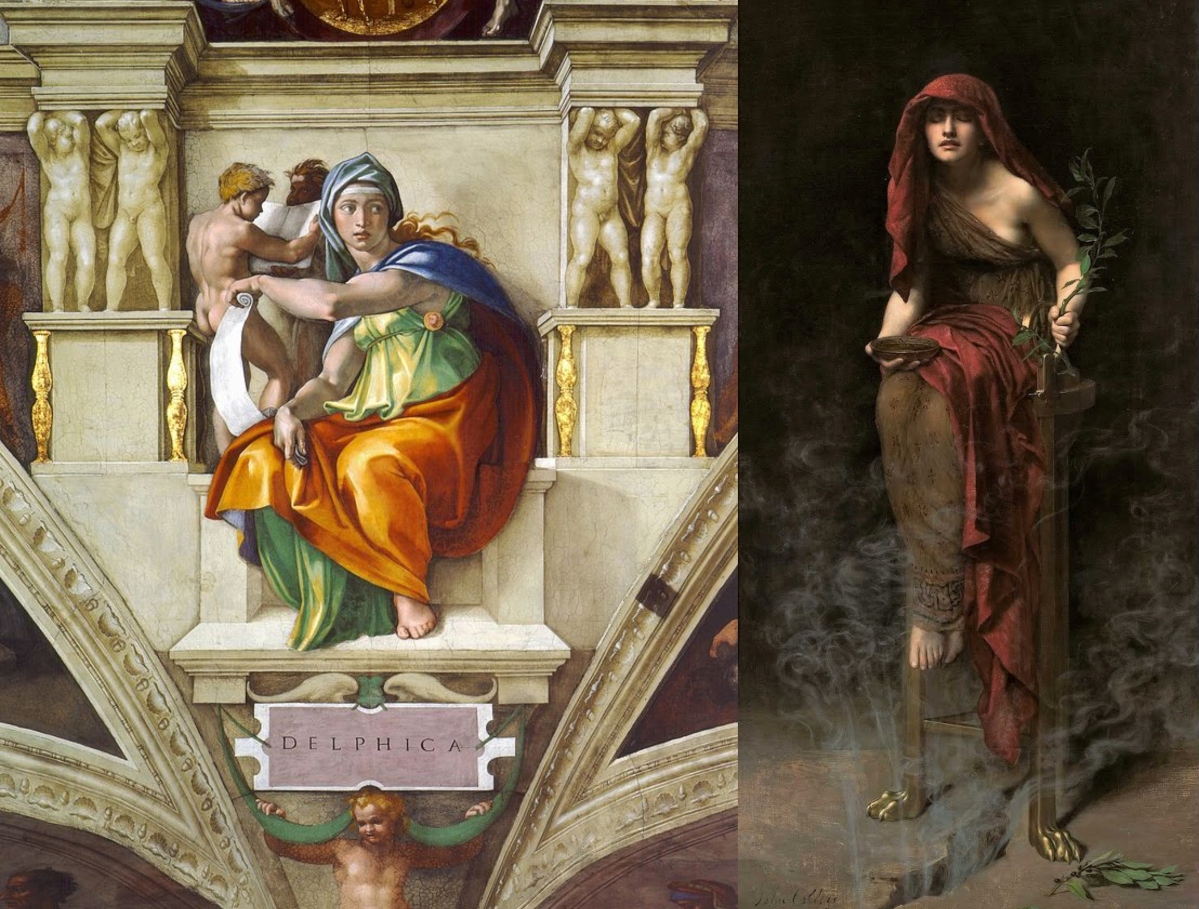 Left: The “Delphic Sibyl” (oracle) from Michelangelo’s Sistine Chapel ceiling (1508–1512); right: Priestess of Delphi, 1891, by John Collier
Left: The “Delphic Sibyl” (oracle) from Michelangelo’s Sistine Chapel ceiling (1508–1512); right: Priestess of Delphi, 1891, by John Collier
The Pythia’s oracles were often notoriously ambiguous; one famous episode demonstrating the obscure nature of these prophecies is narrated by Herodotus in his Histories: as Persians were advancing towards Athens in 480 BC, the city sent delegates to ask Apollo’s priestess about their future. The Pythia predicted that Athens would be completely destroyed, and that the only impregnable fortress would one made of “wooden walls”. According to Herodotus, some of the elder Athenians perceived this as a reassurance that the Acropolis, which used to have wooden walls at an earlier point, would be safe from the Persian invasion. Others, led by Themistocles, believed that the wooden walls were a metaphor for the powerful Athenian fleet, which was their only hope. The Athenian triremes indeed proved to be the city’s best defence at the victorious Battle of Salamis; a few days earlier, Athens had fallen to the hands of Xerxes’ army, Acropolis had been razed and the few that did not evacuate the city were slaughtered.
The Delphic Oracle was mentioned in many more sources, including the writings of Plato, Thucydides, Xenophon, Aristotle, Strabo, Ovid and Plutarch, as many more would come to consult it in the following centuries, from Alexander the Great to the Roman Emperors Nero and Hadrian. The Roman-era Greek traveler and geographer Pausanias gave a detailed account of the site in his Description of Greece.
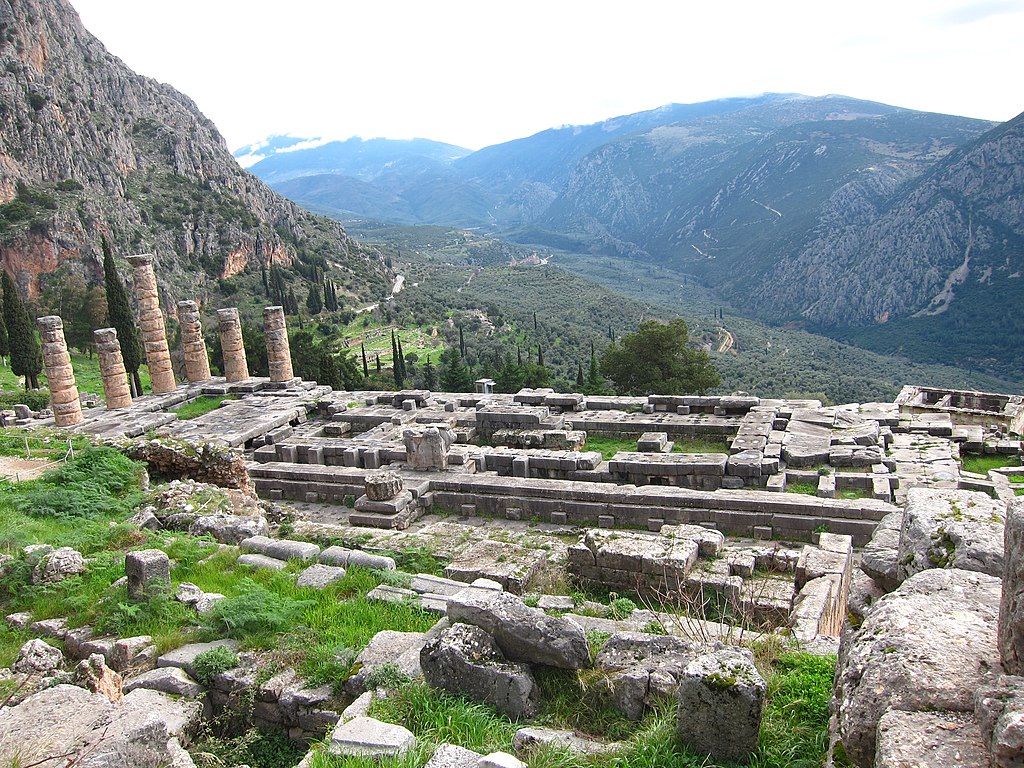 View of the remains of Apollo’s temple (by NikosFF via Wikimedia Commons)
View of the remains of Apollo’s temple (by NikosFF via Wikimedia Commons)
Although it had occasionally been subject to raids and plundering (for instance by Sulla in 86 BC) it was rebuilt and restored, and it remained popular even in early Christian times. Gradually, however, the oracle fell out of use, and the site functioned predominantly as a shrine to Apollo and as the seat of the Pythian Games.
Roman Emperor Julian (331–363 AD), known in Byzantine historiography as “the Apostate” for attempting to revive idolatry (contrary to his Christian predecessors and successors), tried to bring back the institution of the oracle. According to a legend recounted by Church historian Philostorgius, the emperor’s envoy visited the temple to offer his services, only to receive the answer “[…] Phoebus no longer has his house, nor the prophesying laurel, nor the speaking well. The speaking water has dried out.”
Emperor Theodosius would completely abolish pagan cults in 391 AD, and the sanctuary was completely abandoned. Delphi would then become an Episcopal seat for a short time, until the Slavic raids of the 7th century. The site would be gradually covered by soil deposition and a settlement started forming there at some point around the fifteenth century, which eventually evolved into the village of Kastri (meaning “castle”). Marble fragments from the remains were used in the buildings (a common practice at the time).
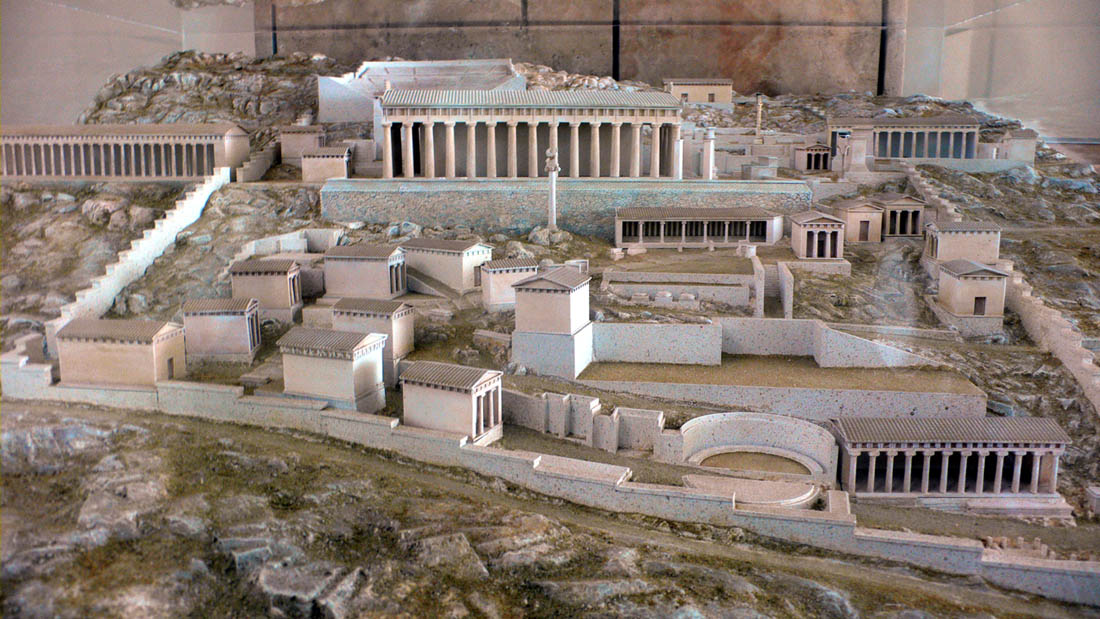 A modern scale model at the Delphi Archaeological Museum, depicting a reconstruction of Apollo’s sanctuary (by Nanosanchez via Wikimedia Commons)
A modern scale model at the Delphi Archaeological Museum, depicting a reconstruction of Apollo’s sanctuary (by Nanosanchez via Wikimedia Commons)
The archaeological site of Delphi
Archaeological research at Delphi began in 1860 by the German archaeologists. In 1891, the Greek government granted the French School at Athens permission for long-term excavations on the site. By then, a powerful earthquake had partly destroyed the village of Kastri, which helped convince the inhabitants to permanently move to a different location conceded to them. Thus took place the so-called “Great Excavation” (La Grande Fouille) which brought to light spectacular finds, including around three thousand inscriptions which greatly added to our knowledge of public and private life in ancient Greece. Excavation work for the archaeological investigation and conservation of the two sanctuaries of Delphi continues to the present day, carried out by the Greek Archaeological Service in cooperation with the French School of Athens. The site was inscribed on the UNESCO World Heritage List in 1987.
The entire city of Delphi had developed around Apollo’s sanctuary, which was encircled by a peribolos (enclosure wall) with a main entrance at the south-eastern corner. From there, visitors accessed the Sacred Way, a winding paved road leading to the temple of Apollo: a peripteros (temple surrounded by a portico with columns) of the Doric order, built on a terrace supported by a polygonal wall. There laid the stone believed to mark the centre of the world, called omphalion from the word omphalos “navel”. The sanctuary began to expand over time, with artificial terraces supported by retaining walls, and was bordered by porticoes called stoas (Stoa of Attalus, Stoa of the Aetolians, Stoa of the Athenians), accessed through corresponding gates in the surrounding walls.
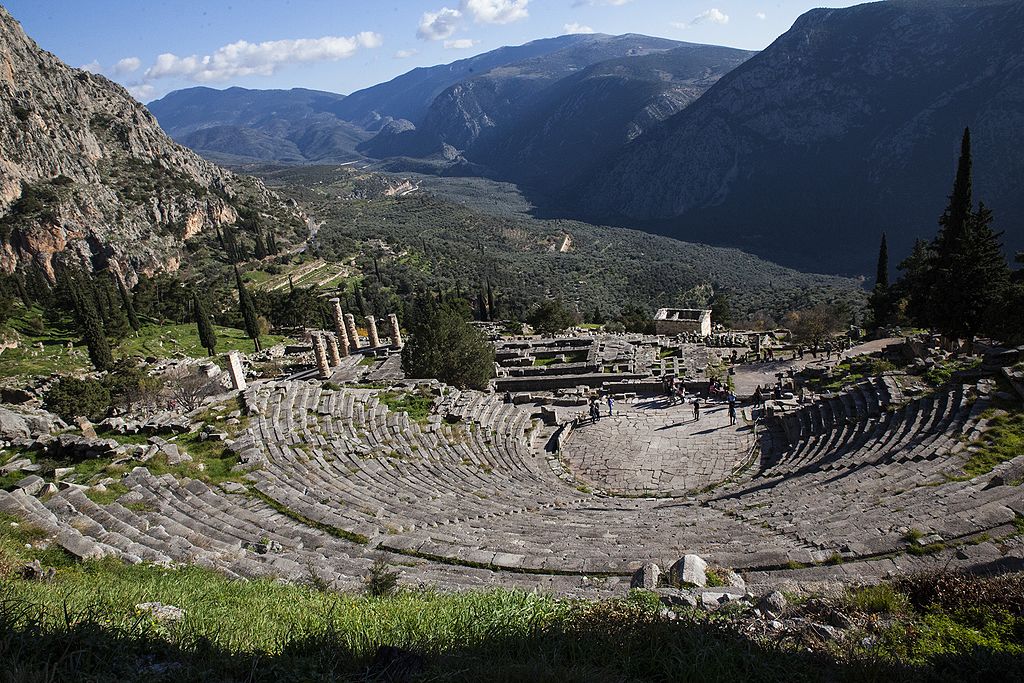 The theatre of Delphi, with Apollo’s temple visible in the background (by Filippos Marinakis via Wikimedia Commons)
The theatre of Delphi, with Apollo’s temple visible in the background (by Filippos Marinakis via Wikimedia Commons)
Scattered among these buildings and along the Via Sacra were numerous monuments and votive buildings (the so-called “Treasuries”), columns and statues dedicated to the god by Greek cities or wealthy individuals on the occasion of socio-political events, or simply to express gratitude for the prophecies. The famous Treasury of the Athenians, a small Doric temple erected to commemorate the Battle of Marathon (490 BC), stands out among them.
Inside the sanctuary, against the north-east corner of its enclosure wall, stands the theatre of Delphi where the music, drama and poetry competitions of the Pythian Games took place, while further up, outside the sacred precincts, is the stadium where athletic competitions were held.
In a ravine between a pair of cliffs called the Phaedriades, east of the sanctuary of Delphi, flows the Castalia spring. The Pythia, the priests and the temple staff used to cleanse themselves there, and also used its waters to clean the temple. Those who visited the sanctuary to consult the oracle also had to cleanse themselves in its waters.
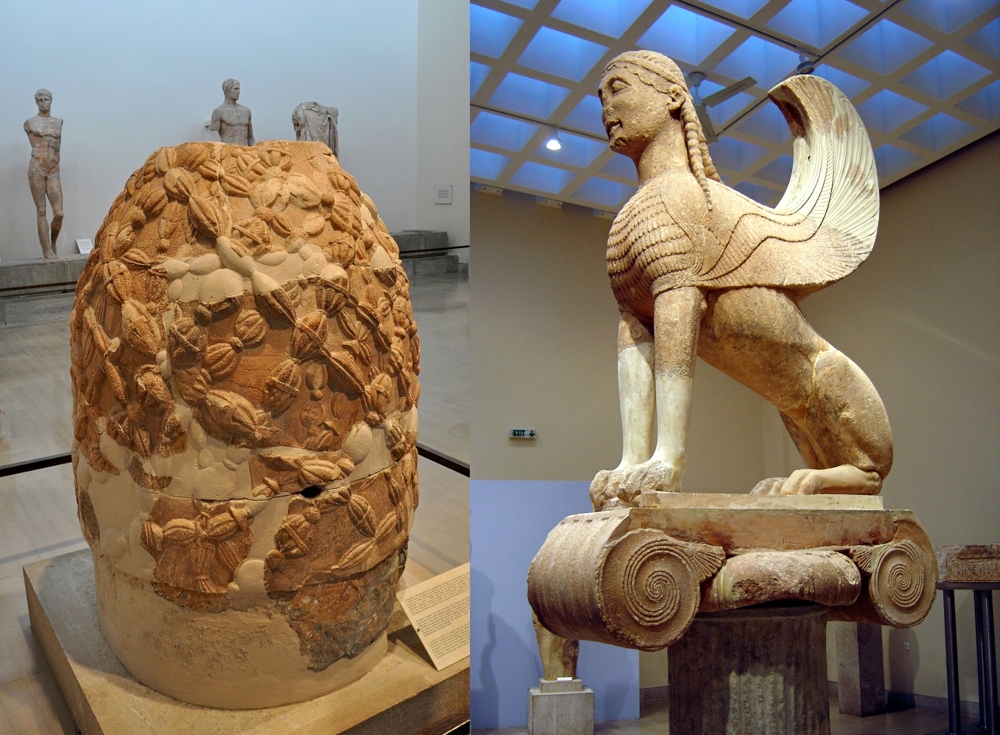 Left: marble-carved stone of the Omphalos at Delphi Museum (by Helen Simonsson via Wikimedia Commons); right: the Sphinx of the Treasury of Naxos at Delphi Museum (by Ricardo André Frantz via Wikimedia Commons)
Left: marble-carved stone of the Omphalos at Delphi Museum (by Helen Simonsson via Wikimedia Commons); right: the Sphinx of the Treasury of Naxos at Delphi Museum (by Ricardo André Frantz via Wikimedia Commons)
On their way to the imposing temple of Apollo, visitors arriving from Athens would find themselves before the sanctuary of Athena Pronaia, meaning “which stands before the temple” (of Apollo). Also enclosed in a peribolos, the sanctuary consists of two temples (at least one of which was dedicated to Athena), a number of independent altars and votive buildings and two treasuries (one of the Doric and one of the other Aeolian order); among them stands out the Tholos, a circular temple of hitherto unknown function featuring two rows of Doric columns, which has come to be one of Delphi’s most recognisable monuments.
The Delphi Archaeological Museum is one of the most important of its kind in Greece, featuring many impressive finds from the local excavations. Among its most famous exhibits we find two large archaic male statues called the Kouroi of Delphi, the fragments of three chryselephantine statues believed to represent Apollo, Artemis and their mother Leto, the Sphinx of the Treasury of Naxos, the marble-carved stone of the Omphalos (representing earth’s navel), the Roman statue of Antinous and, most importantly, the 5th century bronze sculpture known as the Charioteer of Delphi.
Read also via Greek News Agenda: Ancient Olympia: Panhellenic Sanctuary and home of the Olympics; Delos, the Sacred Island; Temple of Apollo Epicurius at Bassae; The archaeological sites of Mycenae and Tiryns; Philippi: a “small Rome” in Macedonia; Ancient Athenian & Attic Festivals
N.M. (Based on the original article which appeared on Punto Grecia; intro image: View of the sanctuary of Athena Pronaia with the Tholos, by Tamara Semina via Wikimedia Commons)

